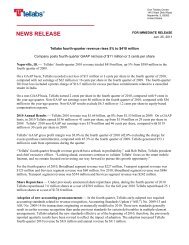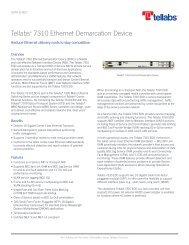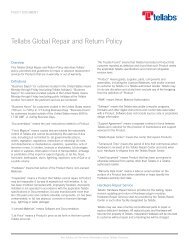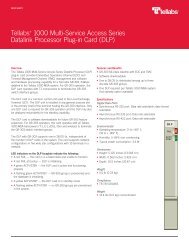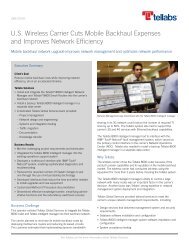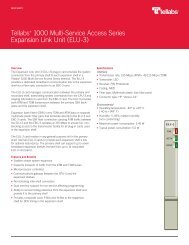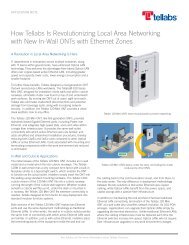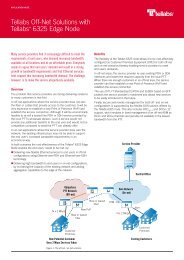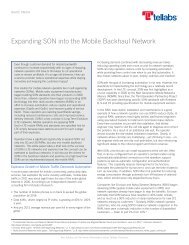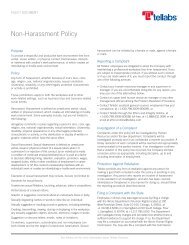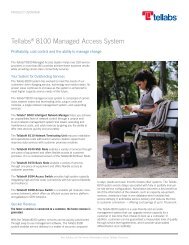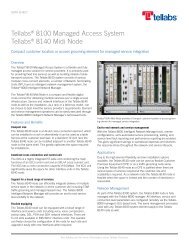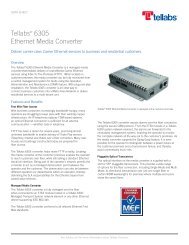An IP Backhaul Solution for Today and Tomorrow - Tellabs
An IP Backhaul Solution for Today and Tomorrow - Tellabs
An IP Backhaul Solution for Today and Tomorrow - Tellabs
Create successful ePaper yourself
Turn your PDF publications into a flip-book with our unique Google optimized e-Paper software.
AN <strong>IP</strong> BACKHAUL<br />
SOLUTION FOR TODAY<br />
AND TOMORROW How <strong>Tellabs</strong>® ® 8600 Smart Routers<br />
are helping German operator E-Plus<br />
build its new mobile backhaul network<br />
By M.J. Richter<br />
Insight Q1 2013 11
MOBILE BACKHAUL<br />
Delivering what customers want has been the E-Plus Group’s driving philosophy<br />
ever since the German mobile operator entered the market nearly two decades<br />
ago.<br />
For many years, E-Plus differentiated itself successfully with voice service innovations<br />
in the German market. Customers were attracted by flexible tariff models or even<br />
flat rates—but smartphones, tablets <strong>and</strong> dongles make today’s consumers much<br />
more b<strong>and</strong>width hungry <strong>and</strong> dem<strong>and</strong>ing of data services enabled with mobile<br />
Internet access.<br />
To meet these challenges, E-Plus is rebuilding its nationwide mobile backhaul<br />
network.<br />
“Updating our mobile backhaul infrastructure is critical <strong>for</strong> delivering the faster<br />
access that customers want,” says Gerhard Lüdtke, Director of Access <strong>and</strong><br />
Transport Networks at E-Plus.<br />
Opting <strong>for</strong> an <strong>IP</strong> radio access network (<strong>IP</strong>-RAN) architecture, E-Plus has selected<br />
a combination of packet nodes using <strong>Tellabs</strong> ® 8600 Smart Routers <strong>and</strong> Ericsson<br />
MINI-LINK microwave solutions <strong>for</strong> first- <strong>and</strong> second-mile segments.<br />
“In addition to enabling E-Plus to provide faster access to the mobile Internet,<br />
this investment will future-proof our network <strong>and</strong> make it a more cost-effective<br />
foundation <strong>for</strong> our mobile broadb<strong>and</strong> business,” Mr. Lüdtke says.<br />
“E-Plus required a<br />
transition from our<br />
ATM technology<br />
foundation toward <strong>IP</strong><br />
routing <strong>and</strong> the<br />
<strong>Tellabs</strong> 8600 packet<br />
nodes were the most<br />
economic enabler.”<br />
—Gerhard Lüdtke,<br />
Director of Access <strong>and</strong><br />
Transport Networks at<br />
E-Plus<br />
Powering a new backhaul strategy<br />
When measured by the size of its customer base, E-Plus, with 24 million subscribers,<br />
is the third-largest German mobile operator, behind T-Mobile <strong>and</strong> Vodafone. A subsidiary<br />
of KPN International, E-Plus is headquartered in Düsseldorf <strong>and</strong> has more than<br />
4,000 employees throughout the country.<br />
In 2008, when E-Plus began to map out a new backhaul strategy, most operators were<br />
Subscribe to Insight: www.tellabs.com/insight<br />
<strong>IP</strong>: Internet Protocol<br />
RAN: Radio Access Network<br />
Insight Q1 2013 12
MOBILE BACKHAUL<br />
“The major differentiator<br />
in the <strong>Tellabs</strong><br />
solution was that<br />
<strong>Tellabs</strong> ® 8000<br />
Intelligent Network<br />
Manager hides<br />
complexity when<br />
operating a countrywide<br />
<strong>IP</strong> network.”<br />
—Gerhard Lüdtke,<br />
Director of Access <strong>and</strong><br />
Transport Networks at<br />
E-Plus<br />
relying on Layer-2 Pseudowire solutions. In essence, these point-to-point circuits are<br />
typically TDM/ATM traffic encapsulations <strong>and</strong> transported over Ethernet connections.<br />
However, as LTE technology gained traction, a shift toward more flexible backhaul<br />
topology implementations found rapid acceptance in the industry. Consequently, E-Plus<br />
decided to adopt an innovative <strong>IP</strong>-routed RAN strategy <strong>for</strong> its backhaul renewal.<br />
Within wireless networks around the world, RAN evolution is accelerating various migration<br />
strategies toward <strong>IP</strong>-centric networks. While the near-term goal is to provide<br />
faster access <strong>for</strong> its mobile-Internet customers, E-Plus also wanted a technologyagnostic<br />
RAN transport solution. Choosing MPLS decouples bearer <strong>for</strong>mats from<br />
the underlying transport mechanisms. MPLS also enables the coexistence of multiple<br />
technology generations with the most flexible network consolidation at the right point<br />
in time.<br />
“E-Plus has an ATM-based network, <strong>and</strong> ATM switches are quite constrained in the<br />
amount of traffic they can h<strong>and</strong>le,” Mr. Lüdtke says. “So we were limited in our offering<br />
of higher-capacity data services, which become increasingly interesting <strong>for</strong> consumers.<br />
There<strong>for</strong>e, a transition from our ATM technology foundation toward <strong>IP</strong> routing was required<br />
<strong>and</strong> the <strong>Tellabs</strong> 8600 packet nodes were the most economic enabler.”<br />
To h<strong>and</strong>le such a huge network initiative, E-Plus wanted a system integrator with<br />
expertise <strong>and</strong> experience <strong>for</strong> all the required infrastructure components. Ultimately,<br />
E-Plus awarded Ericsson Germany GmbH the contract to build the new <strong>IP</strong>-RAN endto-end.<br />
<strong>Tellabs</strong> designed its modular <strong>IP</strong>/MPLS-based <strong>Tellabs</strong> 8600 Smart Routers to help<br />
operators like E-Plus deploy economic pay-as-you-grow networks. The <strong>Tellabs</strong> 8600<br />
series is an extensive portfolio of right-sized network elements that cover any traffic<br />
requirements, from small cell sites through various aggregation layers up to the RNC<br />
<strong>and</strong> gateway locations <strong>for</strong> traffic termination with h<strong>and</strong>off to the core.<br />
Subscribe to Insight: www.tellabs.com/insight<br />
ATM: Asynchronous Transfer<br />
Mode<br />
LTE: Long-term Evolution<br />
MPLS: Multi-Protocol Label<br />
Switching<br />
RNC: Radio Network Controller<br />
TDM: Time Division<br />
Multiplexing<br />
Insight Q1 2013 13
MOBILE BACKHAUL<br />
E-Plus is currently using <strong>Tellabs</strong> ® 8630 <strong>and</strong> 8660 Smart Routers <strong>for</strong> the higher parts<br />
of the network (high radio access network, or HRAN) <strong>and</strong> the small 1RU-high <strong>Tellabs</strong> ®<br />
8609 Smart Router in the lower backhaul areas (low radio access network, or LRAN).<br />
While the HRAN packet nodes always connect to a fiber entry point using either SDH<br />
or Ethernet interfaces of the underlying transmission infrastructure, the LRAN packet<br />
nodes are typically attached to the microwave systems, serving a mix of PDH/SDH <strong>and</strong><br />
Ethernet technologies.<br />
A large backhaul transition project inevitably leads to a temporary co-existence of<br />
parallel infrastructures. One is using TDM/ATM protocols transported via SDH <strong>for</strong> 2G<br />
<strong>and</strong> 3G endpoints. The other leverages Ethernet/<strong>IP</strong> over DWDM <strong>for</strong> HSPA <strong>and</strong> LTE<br />
connectivity. The entire packet-based network anchored by the <strong>Tellabs</strong> 8600 plat<strong>for</strong>m<br />
is readily prepared to converge into a single <strong>IP</strong>-RAN over time.<br />
Unified protection <strong>and</strong> operation is crucial<br />
Topologies in mobile access <strong>and</strong> aggregation networks are complex. Everything from<br />
daisy chain, tree, ring or even partial mesh needs to be supported in the LRAN. That<br />
situation challenges protection <strong>and</strong> a protocol-dependent mix of different concepts<br />
introduces further complexities.<br />
“To satisfy E-Plus’ requirement of a unified operation <strong>and</strong> protection scheme, we decided<br />
to leverage MPLS technology already in LRAN aggregation points,” Robert<br />
Bschorr, senior systems sales engineer at <strong>Tellabs</strong>, explains. “As soon as the traffic gets<br />
to the <strong>Tellabs</strong> 8609 router, acting as demarcation point of the MPLS layer, E-Plus can<br />
leverage the same protection—<strong>and</strong> quality of service—mechanisms consistently<br />
throughout the entire network.”<br />
Subscribe to Insight: www.tellabs.com/insight<br />
2G: Second Generation<br />
3G: Third Generation<br />
DWDM: Dense Wavelength<br />
Division Multiplexing<br />
HRAN: High Radio Access<br />
Network<br />
HSPA: High-Speed Packet<br />
Access<br />
LRAN: Low Radio Access<br />
Network<br />
PDH: Plesiochronous Digital<br />
Hierarchy<br />
SDH: Synchronous Digital<br />
Hierarchy<br />
Insight Q1 2013 14
MOBILE BACKHAUL<br />
With the <strong>Tellabs</strong><br />
8000 INM, all node,<br />
network <strong>and</strong> serviceprovisioning<br />
tasks<br />
are executed solely<br />
through a graphical<br />
user interface.<br />
Intelligent management system hides network complexity<br />
A broad variety of technical <strong>and</strong> commercial advantages persuaded E-Plus to introduce<br />
the <strong>Tellabs</strong> 8600 plat<strong>for</strong>m as a packet node when evaluating <strong>IP</strong>-RAN alternatives. Mr.<br />
Lüdtke says, “The major differentiator in the <strong>Tellabs</strong> solution was that <strong>Tellabs</strong> ® 8000<br />
Intelligent Network Manager hides complexity when operating a country-wide <strong>IP</strong> network.”<br />
“There is a huge difference between an <strong>IP</strong>/MPLS core—which typically consists of a<br />
few dozen routers—<strong>and</strong> a large-scale <strong>IP</strong>/MPLS-based aggregation network comprising<br />
several thous<strong>and</strong> nodes,” Robert says. “The latter greatly elevates scalability problems<br />
<strong>and</strong> the associated operational complexities. There<strong>for</strong>e, we divided the network into<br />
different autonomous systems (AS), <strong>and</strong> made it extremely scalable by designing a<br />
Multi-AS architecture.”<br />
Robert continues, “This is a very robust <strong>and</strong> scalable approach, but these smaller<br />
isl<strong>and</strong>s, further structured by using different <strong>IP</strong> VPNs, create additional complexity when<br />
it comes to Inter-AS communications.”<br />
That’s where the <strong>Tellabs</strong> 8000 INM helps.<br />
For example, operators normally need to provision <strong>and</strong> maintain the routers with their<br />
built-in comm<strong>and</strong> line interfaces (CLI). However, with the <strong>Tellabs</strong> 8000 INM, all node,<br />
network <strong>and</strong> service-provisioning tasks are executed solely through a graphical user<br />
interface. The underlying protocol complexities are completely hidden <strong>and</strong> there is no<br />
need to deal with the CLI to build <strong>and</strong> maintain the network.<br />
Automation becomes key<br />
With the tightest integration of <strong>IP</strong>-router functionalities into one holistic network <strong>and</strong><br />
service management system, the <strong>Tellabs</strong> 8000 INM provides a complete set of tools <strong>for</strong><br />
network pre-planning, building, provisioning, monitoring <strong>and</strong> connection testing.<br />
Automation releases the full potential of the system, <strong>and</strong> offers operators significant<br />
Subscribe to Insight: www.tellabs.com/insight<br />
AS: Autonomous Systems<br />
CLI: Comm<strong>and</strong> Line<br />
Interfaces<br />
INM: Intelligent Network<br />
Manager<br />
VPN: Virtual Private Network<br />
Insight Q1 2013 15
MOBILE BACKHAUL<br />
benefits, such as: wizards <strong>for</strong> the provisioning process; templates <strong>for</strong> ensuring consistent<br />
parameters network-wide; macros <strong>for</strong> mass operations <strong>and</strong> built-in advisors to help<br />
with troubleshooting.<br />
Operators will save on costs when leveraging <strong>and</strong> combining all network <strong>and</strong> service<br />
in<strong>for</strong>mation stored in the <strong>Tellabs</strong> 8000 INM database with complementary operation<br />
<strong>and</strong> business support systems.<br />
“E-Plus’ new <strong>IP</strong>-based backhaul solution not only delivers what our customers expect<br />
today, but also what they’ll need in the future,” Mr. Lüdtke says. ■<br />
Subscribe to Insight: www.tellabs.com/insight<br />
Insight Q1 2013 16



